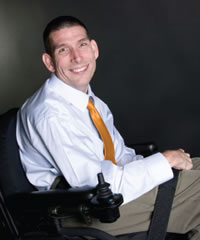Known in online circles as the voice of Wheelchairjunkie.com, Mark Smith’s day job is consumer research manager for Pride Mobility Products, a manufacturer of wheelchairs, seating and accessories. As an author, Smith explains what it’s like to be a wheelchair user — and as an advocate, he pushes for greater independence for people with all types of disabilities.
 Q: Tell us about the chair you’re using.
Q: Tell us about the chair you’re using.
Mark: I’m really the epitome of the complex rehab technology user, having severe cerebral palsy. My seating is asymmetrical; I have muscle tone issues. I’m really as complex as complex gets. I start out with a Group 3 high-performance base, our Q6 Edge. When I say “high performance,” a lot of people think speed. But truly, it’s well beyond that. When you get into complex rehab technology, you’re really getting into seating systems, higher-end electronics, power positioning, etc. So I start out with a high-performance base, meaning larger 14″ drive wheels, six-wheels-on-the-ground technology, mid-wheel technology to turn on a dime, the ability to maneuver indoors, and then go out in varied terrain.
What’s really vital to understand is it needs to serve me across the entire spectrum of life. I need to be able to go from my bathroom in the morning to literally riding my power chair to work to maneuvering around the office during the day and back again, and then obviously chasing my 14-year-old daughter around and living an active lifestyle.
On top of my Group 3 base, I use power positioning — tilt. Because of my asymmetrical posture, I use a customized legrest system, especially designed to help absorb my muscle spasms and to help conform to my tone. I use a custom-formed cushion, our Spectrum Air. For my backrest, I have our Synergy back. I also use specialty electronics — we have our Q-Logic electronics, which is our overall system, and on that we offer several different types of hand controls. In my particular case, based on my cerebral palsy, based on how I have to stabilize my hand while driving, I use our mini stand-alone joystick.
Q: What’s the top speed on your chair?
A: Back in my college days, speed was a lot more important: racing around San Francisco, getting around campus, etc. Over the years, I’ve found that speed tends to be over-glamorized. What I’ve found as I’ve matured is torque, the power in the chair, is really what makes a huge difference.
Unless one is running around town full-blown, in everyday use what we’re dealing with are ramps. We’re dealing with thresholds, grass and gravel, and rough terrain. I have our high-speed motor package, which is 6 mph. Even though I’m able to get to 6 mph, I’m not giving up any real power.
So even though years ago, I was running, for example, a 10-mph power chair, these days what fits my lifestyle much better is being down to 6 mph. I’m still riding my chair back and forth to work, in all sorts of weather. Being able to have that 6 mph and having exceptional torque really makes for a much more liberating chair.
People don’t realize that the faster the chair goes, the less torque there is. When you get to 8-, 9-, 10-mph chairs, you’re giving up torque. The last part of the equation is when you get into torque and you’re talking about 5- to 6-mph models, you’re really getting much better battery range. That’s a huge benefit as well.
Q: You travel extensively. What sorts of challenges do you run into, and how do you use technology to overcome them?
A: When I pack my suitcase, I have all my little tools and tricks that I need to travel with. If you look at something as simple as a battery charger, that obviously takes up space in your luggage.
When I roll into my hotel — obviously, it wasn’t built for me like my custom home. I almost never know what I’m going to get. I always carry an extension cord, because I know I’m going to need to plug in my charger somewhere, yet still have my chair next to my bed so I can transfer. I also have in my travel kit a reacher. The brand is Telestik, and it’s a telescoping magnet/adhesive pad. I’ll be in a hotel bathroom and drop something behind the toilet. I have no way of getting that except for using the reacher.
Q: Your wheelchair seat elevates. How does that help?
A: It makes a huge difference when traveling independently. Hotel maids seem to love to put the hand-held showerhead as high as possible. No matter what hotel I roll into, it’s always 7 feet in the air. To have my seat lift so I can get the showerhead down when I need it makes all the difference in the world.
Prior to having the seat lift, my seat was often a foot lower than the mattress. It makes it easy to get back in my chair — just fall out of bed! — but getting onto the bed was really difficult.
Q: We’ve heard of wheelchair users having trouble with airlines recently.
A: Airplanes are a huge topic of discussion right now. I’ve flown extensively over the last 15 years, and what was interesting was in the late ’90s, before I worked for Pride, I mostly flew alone.
An interesting trend is airlines have been really hassling, in simple terms, people with severe disabilities who fly alone. Despite air carrier regulations and ADA policies and all that, there has been an alarming trend over the last two years.
Part of it is understanding your rights as a disabled passenger and really taking control of the situation.
